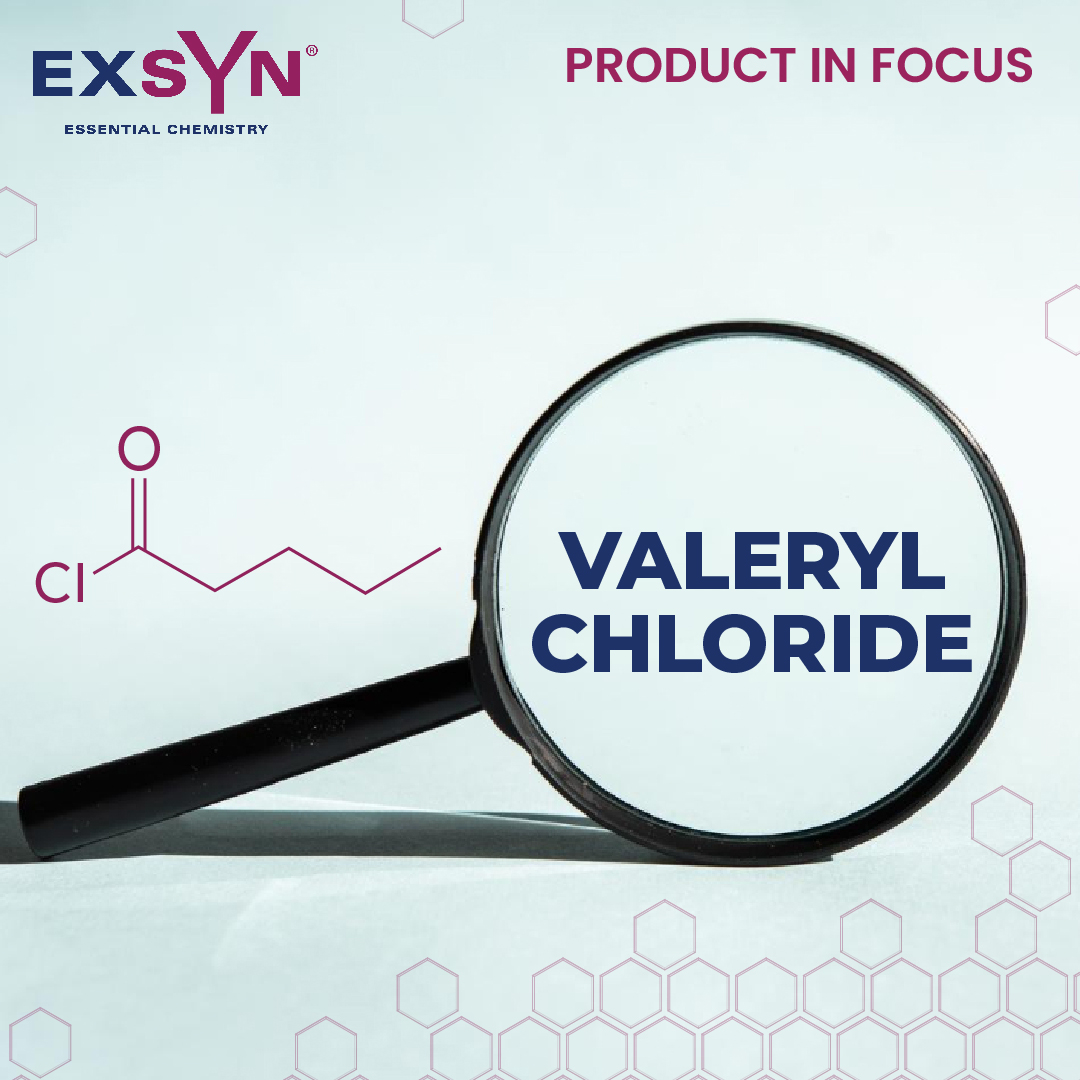INTRODUCTION
Valeryl chloride is an organic liquid belonging to the category – acid chloride. It is a versatile reagent in organic syntheses leading to its diverse applications such as synthesis of enzyme inhibitors, production of APIs, intermediates, and agrochemicals.
Manufacture
Valeryl chloride is produced by chlorination of valeric acid using either phosphorus trichloride or thionyl chloride.
| Synonym | Pentanoyl chloride Valeroyl chloride |
| CAS no. | 638-29-9 |
| EINECS no. | 211-330-1 |
| Molecular formula | C5H9ClO |
| Molecular weight | 120.58 |
| Structure |  |
Applications
| APIS– Valeryl chloride is a KRM in production of: |
|---|
| Irbesartan, an angiotensin |
| Valsartan, also an angiotensin |
| Dronedarone, for indication of cardiac arrhythmias |
| Diflucortolone Valerate, an anti-inflammatory drug |
| Pyrovalerone, a psychoactive drug |
| Intermediates– It also finds uses in synthesis of intermediates such as: |
|---|
| 2-Bromo-1-phenyl-pentan-1-one |
| Valeric anhydride |
| 2-Chloropentanoyl chloride |
| 1-Octen-4-one |
| Phenyl valerate |
| Agrochemicals |
|---|
| Hexaconazole, a fungicide |
| Others |
|---|
| Liquid crystal synthesis |
| Preparation of potent inhibitor of secretory Phospholipase A2 |
| Enantioselective synthesis of propyl isopropyl acetamide (PID) |
Phosphorodiamidites are a unique class of phosphorus-based compounds characterized by one P–O bond and two P–N moieties. 2-Cyanoethyl tetraisopropylphosphorodiamidite plays a crucial role in solid-phase oligonucleotide synthesis. Beyond their application as synthetic precursors for oligonucleotides, phosphorodiamidites have also been reported as valuable starting materials for the synthesis of industrially relevant polymers and flame-resistant materials, including adhesives, coatings, and laminates.
Ferric maltol is an oral iron complex composed of ferric iron (Fe³⁺) chelated with maltol, designed to improve iron absorption while reducing common gastrointestinal side effects associated with traditional iron salts. It is primarily used in the management of iron deficiency with better tolerability.
Phosphatidylcholine (PC) is one of the most important phospholipids derived from soya lecithin and represents a key structural component of cell membranes. Phosphatidylcholine 90% refers to a highly purified grade where the PC content is enriched to around 90% through specialized extraction and purification steps.
Indorez® Kota Resin is a modified non self-cured phenolic resin, it can increase rubber adhesion to steel, polyester, rayon, nylon, aramid and other fabric cord. It’s an adhesive agent, acts as methylene acceptor, can 100% replace resorcinol and resorcinol resins in resorcinol- formaldehyde-silica, enhance adhesion between rubber and reinforcing materials.
Glyceryl Stearate Citrate (GSC) is a plant-derived, biodegradable emulsifier commonly used in cosmetics and personal-care products. It functions primarily as an anionic oil-in-water (O/W) emulsifier, helping blend oils and water into smooth, stable creams and lotions. Its natural origin and gentle profile make it popular in eco-certified, organic, and sensitive-skin formulations.
DL-Serine is a racemic mixture of both the D- and L-forms of the amino acid serine, which is a polar, nonessential amino acid. It is an α-amino acid characterized by its hydroxyl-containing side chain, which enables it to take part in numerous biochemical reactions and synthetic processes. It functions as a pivotal intermediate in the biosynthesis of amino acids, including glycine and cysteine, underscoring its essential role in cellular metabolism. Moreover, it constitutes a critical pharmaceutical intermediate for the synthesis of a broad spectrum of therapeutic agents and drug candidates.
Ethyl vinyl ether is a reactive, flammable, volatile liquid with a strong ether-like odor. Featuring two conjugated functional groups—an ether and an alkene—this molecule act as important building block, especially in polymer synthesis. Its applications span multiple industrial sectors, including semiconductors, coatings, inks, fragrances, adhesives, paints, oil viscosity modifiers and pharmaceuticals, with promising potential as a dietary supplement.
Peppermint (Mentha piperita) is a common herb, also known as a hybrid mint. Its main components are oxygenated monoterpenes: alcohols, esters and ketones. Peppermint oleoresin microencapsulated powder is a white to off-white coloured powder produced from the seeds of the plant. In order to protect and maintain the stability of peppermint oil, microencapsulation is carried out through process optimization using the coacervation technique. This technique helps limit the loss and degradation of flavours and aromas during processing and storage. It offers versatile applications across multiple industries — from food and beverages to pharmaceuticals, cosmetics, and textiles.
5-Methyl-3-vinyl-2-oxazolidinone (V-MOX) is a highly reactive monomer valued for its low viscosity, mild odor, and excellent reactivity. It is widely used as a reactive diluent in UV-curable inks and coatings, where it enhances adhesion, produces brighter colors, and improves safety compared to conventional diluents. In addition, V-MOX serves as a key building block in the synthesis of kinetic hydrate inhibitor (KHI) polymers, which are applied in oil and gas production to prevent hydrate blockages in pipelines.
